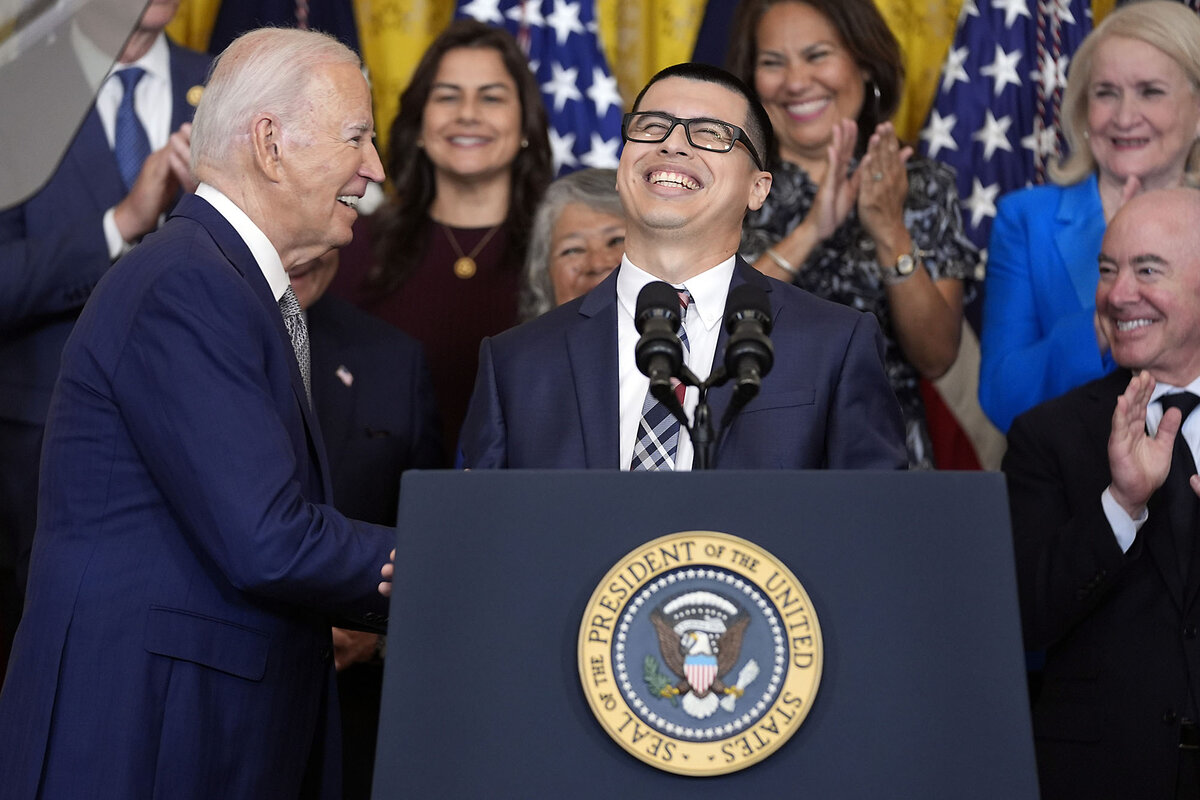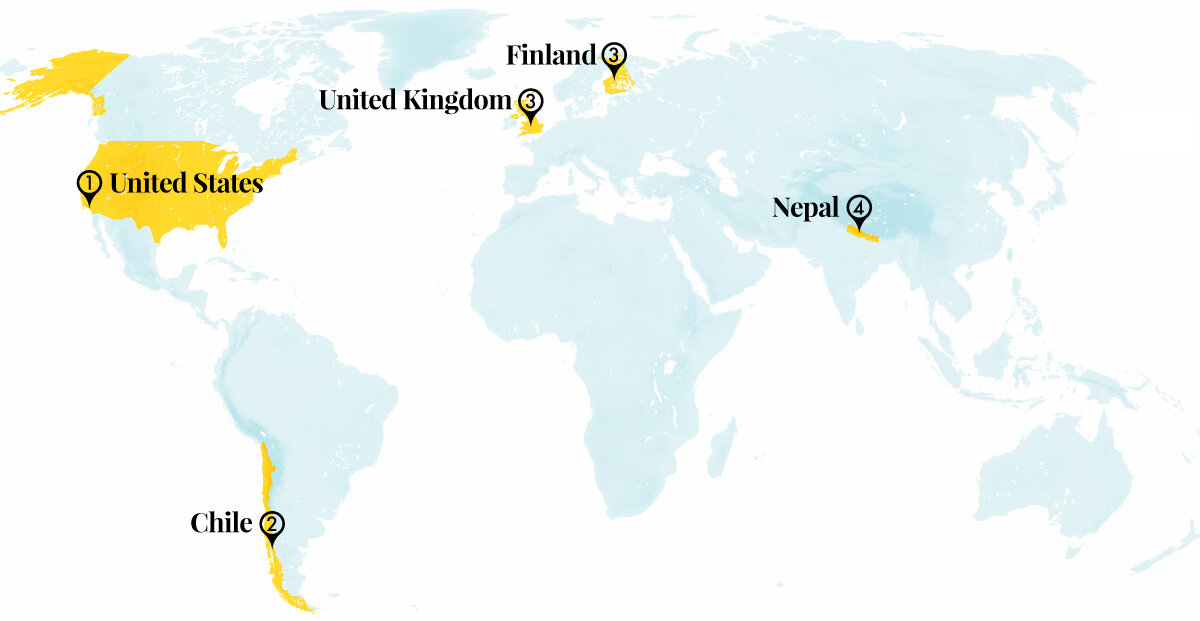U.S. President Joe Biden faces criticism on immigration from a divided public. Back-to-back executive actions appear designed to thread a needle – to make him be seen as both tough and humane.

Why is Christian Science in our name?
Our name is about honesty. The Monitor is owned by The Christian Science Church, and we’ve always been transparent about that.
The Church publishes the Monitor because it sees good journalism as vital to progress in the world. Since 1908, we’ve aimed “to injure no man, but to bless all mankind,” as our founder, Mary Baker Eddy, put it.
Here, you’ll find award-winning journalism not driven by commercial influences – a news organization that takes seriously its mission to uplift the world by seeking solutions and finding reasons for credible hope.
Explore values journalism About usMonitor Daily Podcast
- Follow us:
- Apple Podcasts
- Spotify
- RSS Feed
- Download
 Mark Sappenfield
Mark Sappenfield
Ask a reader to describe the Monitor, and one word you’ll often hear is “hope.” Today’s review of “Inside Out 2” by Cameron Pugh and Troy Aidan Sambajon gives me hope that, just maybe, Pixar can get back to its best.
From “Toy Story” to “Ratatouille,” Pixar did something more than reinvent animation. It produced films of stunning depth, packaged as children’s fare but more likely to leave adults bawling. They reminded us of the power of all those things we most need – innocence, goodness, love, and, yes, hope.
A renewal of those years would be a very welcome sequel.
Help fund Monitor journalism for $11/ month
Already a subscriber? Login

Monitor journalism changes lives because we open that too-small box that most people think they live in. We believe news can and should expand a sense of identity and possibility beyond narrow conventional expectations.
Our work isn't possible without your support.
Today's stories
And why we wrote them
The Explainer
( 6 min. read )
Today’s news briefs
• Thailand marriage bill: Thailand’s Senate votes overwhelmingly to approve a bill to legalize same-sex marriage. The country would become the first in Southeast Asia to enact such a law.
• U.S. heat wave: Extreme heat from Iowa to Maine is forecast to continue until at least Friday as cities including Chicago break records.
• Putin to North Korea: Russian President Vladimir Putin vows to support North Korea against the United States, as he headed to the reclusive nuclear-armed country for the first time in 24 years.
• School cellphones: The Los Angeles Unified School District will consider banning smartphones for its 429,000 students.
( 5 min. read )
Emmanuel Macron’s call for snap elections has flustered the French public, as the prospect of a far-right grip on the government is now very real. But it’s important to understand what’s really at stake in the coming votes.
( 3 min. read )
The prospect of a far-right victory in upcoming elections is rippling though French society in different ways. For many athletes, it has meant breaking longstanding traditions and speaking out politically.
Points of Progress
( 4 min. read )
In our progress roundup, caretakers of the world’s art treasures are changing the way they work to preserve cultural heritage, from Los Angeles to Nepal. And the “Yosemite of South America” is sold for $63 million to conservationists.
Film
( 4 min. read )
“Inside Out 2” doesn’t rise to the heights of Pixar’s greatest classics, like “The Incredibles.” But it’s well worth a trip to a movie theater – a rarity these days. And who couldn’t use a little more Joy in their lives?
The Monitor's View
( 2 min. read )
A new school that opened last month in Ukraine’s second-largest city is only 18 miles from Russia – with only a five-minute warning of incoming missiles. Yet Kharkiv’s primary school 155 is also on the front line of innovative efforts to ensure that children in crisis-affected countries have safe access to education.
The school is the first of many to come in Ukraine that was built with permanent underground classrooms. On opening day in mid-May, a gaggle of third graders – who had never been in a physical school during two years of war – walked down 20 feet of steps into windowless but brightly lit rooms to be taught by their teachers.
“The children have dreamed of meeting their classmates,” one father told Deutsche Welle news media.
Now when air sirens go off, the students will not need to interrupt their studies by running to a bomb shelter. And their bunkerlike school will probably not be destroyed – as nearly 400 schools have been so far by Russian forces.
Education is the most powerful weapon you can use to change the world, said Nelson Mandela, and Ukraine wants to make sure the next generation is prepared to keep the country strong and independent.
“The Ukraine war isn’t merely about soldiers defending their homeland,” wrote American reporter Tim Mak in the news blog Counteroffensive after visiting a temporary underground school in a Kharkiv subway station. “These kids are what those soldiers are fighting to defend.”
Ukraine’s efforts to offer online schooling for some 900,000 students has been admirable, according to Education Cannot Wait, a fund for providing education in emergencies and protracted crises. From repairing bomb-damaged schools to handing out devices for remote learning, the government has prevented significant learning losses.
“We have a unique chance, with global support, to make courageous choices in creating a new education system – one that is high-quality, innovative, secure, and European,” wrote Dr. Yevhen Kudriavets, first deputy minister in Ukraine’s education ministry, in the Kyiv Post.
In the world’s most stressed places, says Education Cannot Wait’s executive director Yasmine Sherif, ensuring a safe education for children allows them to “draw on their resilience, heal from their experiences, develop fully and to prepare their future and unleash their potential.” That’s especially true inside a solid and sunken bunker in a Ukrainian war zone.
A Christian Science Perspective
Each weekday, the Monitor includes one clearly labeled religious article offering spiritual insight on contemporary issues, including the news. The publication – in its various forms – is produced for anyone who cares about the progress of the human endeavor around the world and seeks news reported with compassion, intelligence, and an essentially constructive lens. For many, that caring has religious roots. For many, it does not. The Monitor has always embraced both audiences. The Monitor is owned by a church – The First Church of Christ, Scientist, in Boston – whose founder was concerned with both the state of the world and the quality of available news.
( 3 min. read )
Even when our path seems inharmonious or limited, we can look to God for a spiritual view that uplifts and frees.
Viewfinder

A look ahead
Thank you for joining us today. Tomorrow is the Juneteenth federal holiday in the United States, which means the next Christian Science Monitor Daily will not arrive in your inbox until Thursday. But we’ll have a package of Juneteenth stories to share in a special edition tomorrow, so be on the lookout for that.
In the meantime, please check out Linda Feldmann’s latest Monitor Breakfast with Sen. Mark Warner of Virginia, and Ken Makin’s column on how two young men of character overcame the critics to win the NBA Finals Monday night.
Lastly, in a bit of housekeeping, we want to correct a spelling mistake in a story from last Friday on India’s new coalition government. The correct name of the party we mentioned is Janata Dal United.







